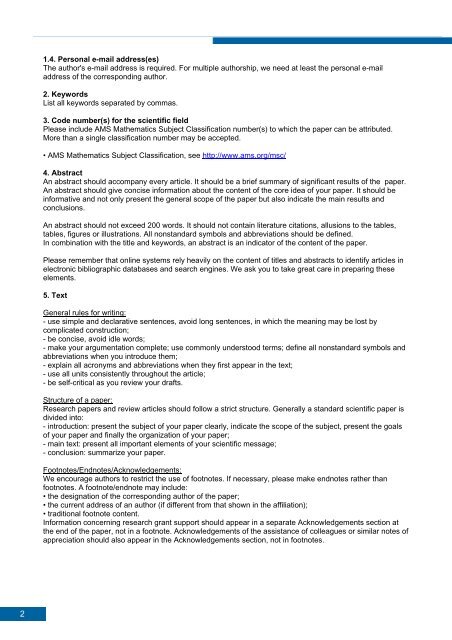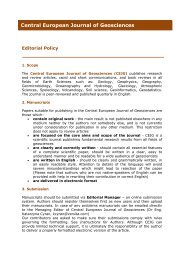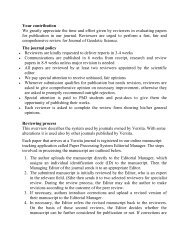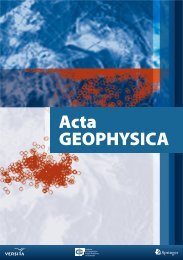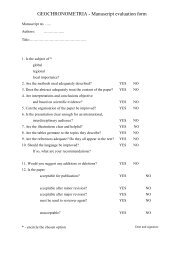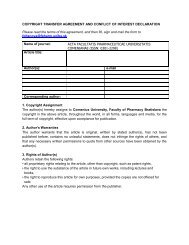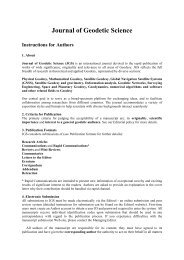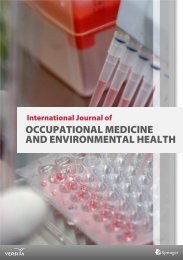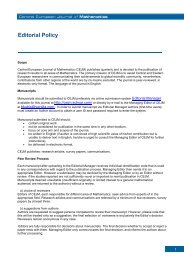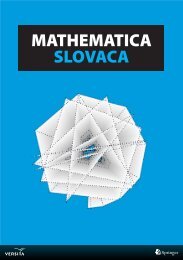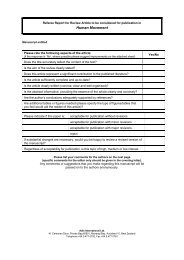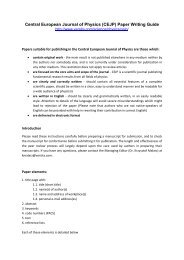Paper Writing Guide - Versita
Paper Writing Guide - Versita
Paper Writing Guide - Versita
You also want an ePaper? Increase the reach of your titles
YUMPU automatically turns print PDFs into web optimized ePapers that Google loves.
1.4. Personal e-mail address(es)<br />
The author's e-mail address is required. For multiple authorship, we need at least the personal e-mail<br />
address of the corresponding author.<br />
2. Keywords<br />
List all keywords separated by commas.<br />
3. Code number(s) for the scientific field<br />
Please include AMS Mathematics Subject Classification number(s) to which the paper can be attributed.<br />
More than a single classification number may be accepted.<br />
• AMS Mathematics Subject Classification, see http://www.ams.org/msc/<br />
4. Abstract<br />
An abstract should accompany every article. It should be a brief summary of significant results of the paper.<br />
An abstract should give concise information about the content of the core idea of your paper. It should be<br />
informative and not only present the general scope of the paper but also indicate the main results and<br />
conclusions.<br />
An abstract should not exceed 200 words. It should not contain literature citations, allusions to the tables,<br />
tables, figures or illustrations. All nonstandard symbols and abbreviations should be defined.<br />
In combination with the title and keywords, an abstract is an indicator of the content of the paper.<br />
Please remember that online systems rely heavily on the content of titles and abstracts to identify articles in<br />
electronic bibliographic databases and search engines. We ask you to take great care in preparing these<br />
elements.<br />
5. Text<br />
General rules for writing:<br />
- use simple and declarative sentences, avoid long sentences, in which the meaning may be lost by<br />
complicated construction;<br />
- be concise, avoid idle words;<br />
- make your argumentation complete; use commonly understood terms; define all nonstandard symbols and<br />
abbreviations when you introduce them;<br />
- explain all acronyms and abbreviations when they first appear in the text;<br />
- use all units consistently throughout the article;<br />
- be self-critical as you review your drafts.<br />
Structure of a paper:<br />
Research papers and review articles should follow a strict structure. Generally a standard scientific paper is<br />
divided into:<br />
- introduction: present the subject of your paper clearly, indicate the scope of the subject, present the goals<br />
of your paper and finally the organization of your paper;<br />
- main text: present all important elements of your scientific message;<br />
- conclusion: summarize your paper.<br />
Footnotes/Endnotes/Acknowledgements:<br />
We encourage authors to restrict the use of footnotes. If necessary, please make endnotes rather than<br />
footnotes. A footnote/endnote may include:<br />
• the designation of the corresponding author of the paper;<br />
• the current address of an author (if different from that shown in the affiliation);<br />
• traditional footnote content.<br />
Information concerning research grant support should appear in a separate Acknowledgements section at<br />
the end of the paper, not in a footnote. Acknowledgements of the assistance of colleagues or similar notes of<br />
appreciation should also appear in the Acknowledgements section, not in footnotes.<br />
2<br />
2


